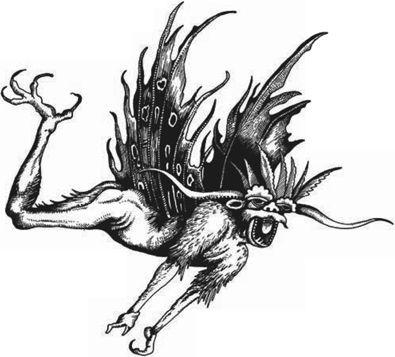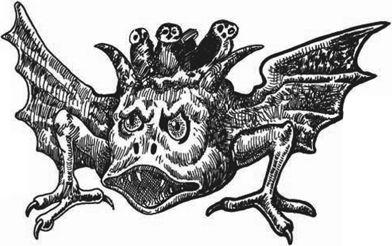The Sorcerer's Companion: A Guide to the Magical World of Harry Potter (23 page)
Read The Sorcerer's Companion: A Guide to the Magical World of Harry Potter Online
Authors: Allan Zola Kronzek,Elizabeth Kronzek

The earliest accounts of demons can be found in the ancient cultures of Mesopotamia, Persia, Egypt, and Israel, where a variety of evil spirits were blamed for disease, crop destruction, floods, fires, plagues, hatred, and war. Demons with names like “the Croucher” and “the Seizer” were thought to lurk anywhere and everywhere—in the deserts and forests, in cellars and on rooftops, and inside homes that had not been properly protected by amulets or magical incantations. Capable of assuming many forms, ancient demons were often said to appear as flies, dogs, bulls, or many-headed monsters.

The European conception of demons evolved from these traditions, as well as from the
daimons
of ancient Greece. These invisible spirits, described as intermediaries between man and the gods, could be either good or bad. Bad daim
ons
led men astray and encouraged evil acts, while good
daimons
were thought to offer positive guidance and protection. The philosopher Socrates claimed that a good
daimon
watched over him throughout his life, whispering advice into his ear and warning him of dangers. Because
daimons
were thought to communicate with the gods, people often tried to summon them for help with magical activities such as casting
spells
or working
curses
. The presence and influence of
daimons
were accepted by everyone in the classical world.
By the late fourth century
A.D.,
daimons
had evolved into demons. Christianity had become the official religion of the vast Roman Empire, and Church leaders taught that the true spirits that occupied the realm between god and men were angels. All pagan spirits—including both good and bad
daimons
—were regarded as fallen angels, or demons, who led men into evil. As in antiquity, demons were held responsible for any kind of misfortune, whether it was an accident, an illness, or even a bad
dream
.
As Christianity grew and spread during the Middle Ages, the many demons of the Middle East were absorbed into Christian lore. All were described as servants of the Devil, but each had his own name, physical description, and particular talents. Asmodeus, for example, was a demon of jealousy, anger, and revenge who specialized in destroying marriages. He was portrayed as having three heads (those of a man, a ram, and a bull), the feet of a goose, and the tail of a snake. Belial was a deceptively handsome demon with a soft voice, who delighted in causing men to become wicked and plagued by guilt. Some of the greatest painters of the Middle Ages and Renaissance let their imaginations run wild in depicting demons in religious paintings, on church walls, and in illuminated manuscripts. By the sixteenth century, the lore of demons had become so elaborate that a detailed catalog of all of Satan’s helpers placed their number at 7,405,926.

The triple-headed demon Asmodeus was said to specialize in destroying marriages and sparking anger and revenge
. (
photo credit 18.2
)
All those demons floating around could hardly be good news. During the era of
witch persecution
in sixteenth- and seventeenth-century Europe, demons became widely associated with witchcraft. Both witches and demons were servants of the Devil, and witches were said to use demons to perform many of their wicked deeds. Most alarming, demons were believed to enter people’s bodies and “possess” them, causing the kind of symptoms that would now be diagnosed as epilepsy or a form of mental illness. Often, demonic possession was attributed to a witch who had placed the demon on a morsel of food eaten by the victim.
Because they were once wise angels, demons were also believed to possess a storehouse of valuable knowledge about such diverse subjects as mathematics, medicinal herbs, geometry, flying, and how to become invisible. This made it extremely tempting for would-be sorcerers to try to contact them and gain access to their secrets. But demons were quite wily, and according to popular lore had many ways to harm or destroy those foolish enough to attempt to communicate with them. Summoning demons was a highly illegal activity, and in many parts of Europe was punishable by death.

If you’re worried that demons lurk in every dark alley, you may be able to draw some comfort from the ability to recognize one when you see it. Although demons hail from many lands, they do share a number of physical characteristics that make them hard to miss.
Most demons walk upright and combine recognizable human features with those of a beast. More than one head is common, as is either an abundance or a shortage of fingers and toes. Many demons sport batlike wings, tails, talons, and horns—though they usually tuck these appendages out of sight when they go out stalking prey. Their mouths are often grotesque and distorted, with jutting fangs and long curly tongues. Some have no skin, and almost all have half their bodies covered by scales or feathers.
The dead giveaway for most demons, however, is their feet. While the rest of the creature may resemble a beautiful woman, a three-headed tiger, or anything else you might imagine, the feet will always be those of a goat, pig, rooster, or goose, or in the case of a water demon, the tail of a fish or snake.
Still, not all demons are associated with Dark forces. In some cultures, demons aren’t interested in leading men into the ways of evil; they merely want to have them for supper! In other cases, they attack only to defend their territories—the woods, mountains, deserts, lakes, and rivers where they commonly dwell—from human invasion. But throughout the world, demons represent all that is scary, both in the natural world and inside ourselves. Like people, demons will rant and rage, scheme and plot, deceive and seduce, and display boundless energy (they “work like demons”) to get what they want. Fortunately, in almost all cases, demons can be outwitted—the most powerful weapons against them being human ingenuity, truth, love, and in many cases, laughter.




